Christian Simon
LIM\&BIO
Crowdsource, Crawl, or Generate? Creating SEA-VL, a Multicultural Vision-Language Dataset for Southeast Asia
Mar 10, 2025Abstract:Southeast Asia (SEA) is a region of extraordinary linguistic and cultural diversity, yet it remains significantly underrepresented in vision-language (VL) research. This often results in artificial intelligence (AI) models that fail to capture SEA cultural nuances. To fill this gap, we present SEA-VL, an open-source initiative dedicated to developing high-quality, culturally relevant data for SEA languages. By involving contributors from SEA countries, SEA-VL aims to ensure better cultural relevance and diversity, fostering greater inclusivity of underrepresented languages in VL research. Beyond crowdsourcing, our initiative goes one step further in the exploration of the automatic collection of culturally relevant images through crawling and image generation. First, we find that image crawling achieves approximately ~85% cultural relevance while being more cost- and time-efficient than crowdsourcing. Second, despite the substantial progress in generative vision models, synthetic images remain unreliable in accurately reflecting SEA cultures. The generated images often fail to reflect the nuanced traditions and cultural contexts of the region. Collectively, we gather 1.28M SEA culturally-relevant images, more than 50 times larger than other existing datasets. Through SEA-VL, we aim to bridge the representation gap in SEA, fostering the development of more inclusive AI systems that authentically represent diverse cultures across SEA.
CCStereo: Audio-Visual Contextual and Contrastive Learning for Binaural Audio Generation
Jan 06, 2025Abstract:Binaural audio generation (BAG) aims to convert monaural audio to stereo audio using visual prompts, requiring a deep understanding of spatial and semantic information. However, current models risk overfitting to room environments and lose fine-grained spatial details. In this paper, we propose a new audio-visual binaural generation model incorporating an audio-visual conditional normalisation layer that dynamically aligns the mean and variance of the target difference audio features using visual context, along with a new contrastive learning method to enhance spatial sensitivity by mining negative samples from shuffled visual features. We also introduce a cost-efficient way to utilise test-time augmentation in video data to enhance performance. Our approach achieves state-of-the-art generation accuracy on the FAIR-Play and MUSIC-Stereo benchmarks.
SAVGBench: Benchmarking Spatially Aligned Audio-Video Generation
Dec 18, 2024



Abstract:This work addresses the lack of multimodal generative models capable of producing high-quality videos with spatially aligned audio. While recent advancements in generative models have been successful in video generation, they often overlook the spatial alignment between audio and visuals, which is essential for immersive experiences. To tackle this problem, we establish a new research direction in benchmarking Spatially Aligned Audio-Video Generation (SAVG). We propose three key components for the benchmark: dataset, baseline, and metrics. We introduce a spatially aligned audio-visual dataset, derived from an audio-visual dataset consisting of multichannel audio, video, and spatiotemporal annotations of sound events. We propose a baseline audio-visual diffusion model focused on stereo audio-visual joint learning to accommodate spatial sound. Finally, we present metrics to evaluate video and spatial audio quality, including a new spatial audio-visual alignment metric. Our experimental result demonstrates that gaps exist between the baseline model and ground truth in terms of video and audio quality, and spatial alignment between both modalities.
Mining Your Own Secrets: Diffusion Classifier Scores for Continual Personalization of Text-to-Image Diffusion Models
Oct 02, 2024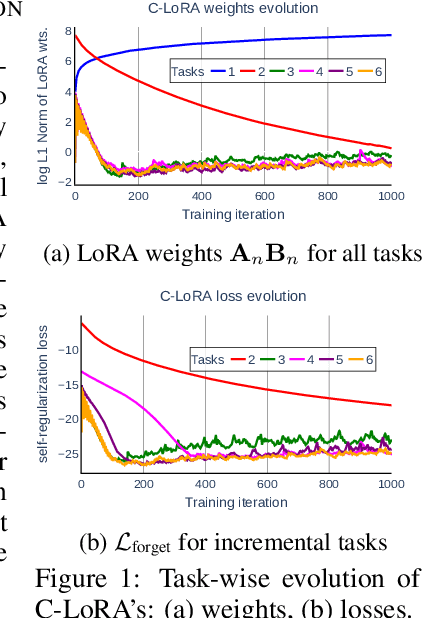
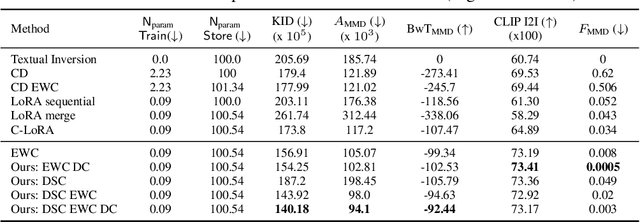
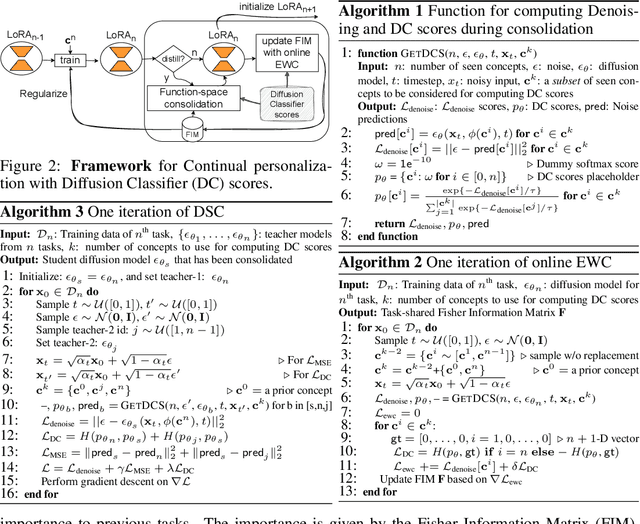
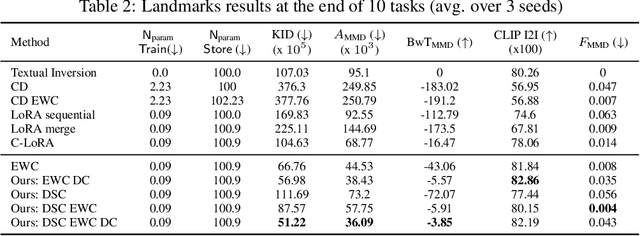
Abstract:Personalized text-to-image diffusion models have grown popular for their ability to efficiently acquire a new concept from user-defined text descriptions and a few images. However, in the real world, a user may wish to personalize a model on multiple concepts but one at a time, with no access to the data from previous concepts due to storage/privacy concerns. When faced with this continual learning (CL) setup, most personalization methods fail to find a balance between acquiring new concepts and retaining previous ones -- a challenge that continual personalization (CP) aims to solve. Inspired by the successful CL methods that rely on class-specific information for regularization, we resort to the inherent class-conditioned density estimates, also known as diffusion classifier (DC) scores, for continual personalization of text-to-image diffusion models. Namely, we propose using DC scores for regularizing the parameter-space and function-space of text-to-image diffusion models, to achieve continual personalization. Using several diverse evaluation setups, datasets, and metrics, we show that our proposed regularization-based CP methods outperform the state-of-the-art C-LoRA, and other baselines. Finally, by operating in the replay-free CL setup and on low-rank adapters, our method incurs zero storage and parameter overhead, respectively, over the state-of-the-art.
A randomized simulation trial evaluating ABiMed, a clinical decision support system for medication reviews and polypharmacy management
Sep 03, 2024Abstract:Background: Medication review is a structured interview of the patient, performed by the pharmacist and aimed at optimizing drug treatments. In practice, medication review is a long and cognitively-demanding task that requires specific knowledge. Clinical practice guidelines have been proposed, but their application is tedious. Methods: We designed ABiMed, a clinical decision support system for medication reviews, based on the implementation of the STOPP/START v2 guidelines and on the visual presentation of aggregated drug knowledge using tables, graphs and flower glyphs. We evaluated ABiMed with 39 community pharmacists during a randomized simulation trial, each pharmacist performing a medication review for two fictitious patients without ABiMed, and two others with ABiMed. We recorded the problems identified by the pharmacists, the interventions proposed, the response time, the perceived usability and the comments. Pharmacists' medication reviews were compared to an expert-designed gold standard. Results: With ABiMed, pharmacists found 1.6 times more relevant drug-related problems during the medication review (p=1.1e-12) and proposed better interventions (p=9.8e-9), without needing more time (p=0.56). The System Usability Scale score is 82.7, which is ranked "excellent". In their comments, pharmacists appreciated the visual aspect of ABiMed and its ability to compare the current treatment with the proposed one. A multifactor analysis showed no difference in the support offered by ABiMed according to the pharmacist's age or sex, in terms of percentage of problems identified or quality of the proposed interventions. Conclusions: The use of an intelligent and visual clinical decision support system can help pharmacists when they perform medication reviews. Our main perspective is the validation of the system in clinical conditions.
Hyper-VolTran: Fast and Generalizable One-Shot Image to 3D Object Structure via HyperNetworks
Jan 05, 2024



Abstract:Solving image-to-3D from a single view is an ill-posed problem, and current neural reconstruction methods addressing it through diffusion models still rely on scene-specific optimization, constraining their generalization capability. To overcome the limitations of existing approaches regarding generalization and consistency, we introduce a novel neural rendering technique. Our approach employs the signed distance function as the surface representation and incorporates generalizable priors through geometry-encoding volumes and HyperNetworks. Specifically, our method builds neural encoding volumes from generated multi-view inputs. We adjust the weights of the SDF network conditioned on an input image at test-time to allow model adaptation to novel scenes in a feed-forward manner via HyperNetworks. To mitigate artifacts derived from the synthesized views, we propose the use of a volume transformer module to improve the aggregation of image features instead of processing each viewpoint separately. Through our proposed method, dubbed as Hyper-VolTran, we avoid the bottleneck of scene-specific optimization and maintain consistency across the images generated from multiple viewpoints. Our experiments show the advantages of our proposed approach with consistent results and rapid generation.
ABiMed: An intelligent and visual clinical decision support system for medication reviews and polypharmacy management
Dec 13, 2023Abstract:Background: Polypharmacy, i.e. taking five drugs or more, is both a public health and an economic issue. Medication reviews are structured interviews of the patient by the community pharmacist, aiming at optimizing the drug treatment and deprescribing useless, redundant or dangerous drugs. However, they remain difficult to perform and time-consuming. Several clinical decision support systems were developed for helping clinicians to manage polypharmacy. However, most were limited to the implementation of clinical practice guidelines. In this work, our objective is to design an innovative clinical decision support system for medication reviews and polypharmacy management, named ABiMed. Methods: ABiMed associates several approaches: guidelines implementation, but the automatic extraction of patient data from the GP's electronic health record and its transfer to the pharmacist, and the visual presentation of contextualized drug knowledge using visual analytics. We performed an ergonomic assessment and qualitative evaluations involving pharmacists and GPs during focus groups and workshops. Results: We describe the proposed architecture, which allows a collaborative multi-user usage. We present the various screens of ABiMed for entering or verifying patient data, for accessing drug knowledge (posology, adverse effects, interactions), for viewing STOPP/START rules and for suggesting modification to the treatment. Qualitative evaluations showed that health professionals were highly interested by our approach, associating the automatic guidelines execution with the visual presentation of drug knowledge. Conclusions: The association of guidelines implementation with visual presentation of knowledge is a promising approach for managing polypharmacy. Future works will focus on the improvement and the evaluation of ABiMed.
On Manipulating Scene Text in the Wild with Diffusion Models
Nov 03, 2023Abstract:Diffusion models have gained attention for image editing yielding impressive results in text-to-image tasks. On the downside, one might notice that generated images of stable diffusion models suffer from deteriorated details. This pitfall impacts image editing tasks that require information preservation e.g., scene text editing. As a desired result, the model must show the capability to replace the text on the source image to the target text while preserving the details e.g., color, font size, and background. To leverage the potential of diffusion models, in this work, we introduce Diffusion-BasEd Scene Text manipulation Network so-called DBEST. Specifically, we design two adaptation strategies, namely one-shot style adaptation and text-recognition guidance. In experiments, we thoroughly assess and compare our proposed method against state-of-the-arts on various scene text datasets, then provide extensive ablation studies for each granularity to analyze our performance gain. Also, we demonstrate the effectiveness of our proposed method to synthesize scene text indicated by competitive Optical Character Recognition (OCR) accuracy. Our method achieves 94.15% and 98.12% on COCO-text and ICDAR2013 datasets for character-level evaluation.
FLATTEN: optical FLow-guided ATTENtion for consistent text-to-video editing
Oct 09, 2023

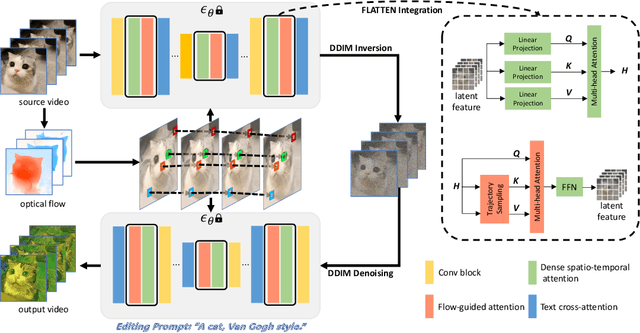

Abstract:Text-to-video editing aims to edit the visual appearance of a source video conditional on textual prompts. A major challenge in this task is to ensure that all frames in the edited video are visually consistent. Most recent works apply advanced text-to-image diffusion models to this task by inflating 2D spatial attention in the U-Net into spatio-temporal attention. Although temporal context can be added through spatio-temporal attention, it may introduce some irrelevant information for each patch and therefore cause inconsistency in the edited video. In this paper, for the first time, we introduce optical flow into the attention module in the diffusion model's U-Net to address the inconsistency issue for text-to-video editing. Our method, FLATTEN, enforces the patches on the same flow path across different frames to attend to each other in the attention module, thus improving the visual consistency in the edited videos. Additionally, our method is training-free and can be seamlessly integrated into any diffusion-based text-to-video editing methods and improve their visual consistency. Experiment results on existing text-to-video editing benchmarks show that our proposed method achieves the new state-of-the-art performance. In particular, our method excels in maintaining the visual consistency in the edited videos.
Subspace Distillation for Continual Learning
Aug 01, 2023Abstract:An ultimate objective in continual learning is to preserve knowledge learned in preceding tasks while learning new tasks. To mitigate forgetting prior knowledge, we propose a novel knowledge distillation technique that takes into the account the manifold structure of the latent/output space of a neural network in learning novel tasks. To achieve this, we propose to approximate the data manifold up-to its first order, hence benefiting from linear subspaces to model the structure and maintain the knowledge of a neural network while learning novel concepts. We demonstrate that the modeling with subspaces provides several intriguing properties, including robustness to noise and therefore effective for mitigating Catastrophic Forgetting in continual learning. We also discuss and show how our proposed method can be adopted to address both classification and segmentation problems. Empirically, we observe that our proposed method outperforms various continual learning methods on several challenging datasets including Pascal VOC, and Tiny-Imagenet. Furthermore, we show how the proposed method can be seamlessly combined with existing learning approaches to improve their performances. The codes of this article will be available at https://github.com/csiro-robotics/SDCL.
 Add to Chrome
Add to Chrome Add to Firefox
Add to Firefox Add to Edge
Add to Edge